In the shower the other morning, I was pondering what I could write about in my next blog post. And then as I grabbed my big fluffy towel, it came to me – I’d find images by Edgar Degas (1834-1917) of women after the bath, drying themselves. Surprisingly, I realized I hadn’t yet written about Degas’ pastels on this blog. Time to rectify that! (You can read a blog I wrote about some of Degas’ work on my gailsibley.com blog by clicking here.)
Do you have any idea how many paintings (pastel and oil) Degas painted around this topic?? Plenty! And you can find so many of these images online. What I found though was that much of the information was incomplete – no size, no location. It took me some time to weed through them – I only wanted to present to you work that I found on museum websites with the full information on each piece. All the images here were taken from those websites as I suspect they show the most accurate colour.
After 1875, Degas began to use pastel frequently, even using the medium for finished pieces. In May 1886, at the Eighth (and last) Impressionist Exhibition, Degas exhibited a series of several pastels of nude women involved in bathing – washing, after the bath drying themselves, and combing their hair. They were the talk of the exhibition with some viewers criticizing the ungainly and awkward poses while others commented on the honesty of the depictions and Degas’ use of colour. Certainly, they weren’t idealized pictures of women but rather, images of the modern woman going about her daily ablutions.
Degas continued with this interest in using pastels through the 1890s and into the 1900s. By then, his eyesight had begun to fail and the work became more abstracted and more about the formal elements of painting. The women are less individualized and more a collection of line, colour, texture, and form.
Let’s take a look at some of his pastels of women after the bath, drying themselves (earliest to latest).

Eventually purchased by Claude Monet, this piece shows a figure and surrounding room. The woman and her towel cast a shadow on the bed and this is balanced out by the white petticoat with its highlights and shadows on the right. All the accoutrements of bathing and after the bath are visible – the shallow tub with sponge, the basin and pitcher, and various perfume bottles. The woman is completely at ease looking at herself in the mirror. The open door with its dark rectangle suggests the possible entry of someone, perhaps a client. The figure forms the central pivot around which a picture full of diagonals and parts of objects (the bed and petticoat) swirl. Don’t you love the red slippers? (This painting was painted over a monotype. Degas made a first monotype and then printed a second one over which he created this painting.)

A woman kneels in the tub, drying herself. What looks like a dressing gown lies on the nearby sofa. Like the pastel above, a door is open behind her. We have no sense of this woman’s social class or if she works as a prostitute. She could be any woman at her toilette. Degas’ rendering of the soft glowing skin with its subtle colours and shadows is exquisite. The angle of the head, face hidden in shadow, hair coiled on top, is so beautifully drawn as is the rest of the body. I particularly love the reflected light on her right thigh near her knee. The woman is calm and intent on what she is doing, oblivious of being watched.

Another earlier piece, this pastel feels full of movement with the blur of the towel in motion as a woman dries off. Another brown sofa with towel or dressing gown over it, it supports a kneeling woman, head down and face hidden. I find this piece has a tension in it unlike the pastel above – it comes from the action of the towel and the awkward precariousness of the figure on the sofa. My favourite parts are her feet, right over left, balancing the body, and also the floral wallpaper 🙂


This pastel may well have been in the Eighth Impressionist Exhibition as well. Here we have the full bathtub being used to prop the bather’s foot as she dries it. Is this the same auburn-haired model as in the above paintings? It appears Degas blended areas of the pastel (her centre back, the bathtub, her right leg) as well as leaving areas of hatched lines. There seems to be a strange confusion in the area around the right hand drying the foot – do you see what I mean?

This is a curious piece, with soft and polished parts where the texture of the paper is hardly visible, and other parts where the texture of the paper is clearly evident (at the top). There is none of the hatching or cross-hatching we associate with Degas’ work. There is a fold in the paper near the top which Degas did nothing to hide. This woman sits on a sofa, reaching up to dry the back of her neck. You can see the bathtub barely shown in the background top left.

Like the pastel above (and below), this woman dries the back of her neck. Degas was obviously fascinated by this everyday pose as a woman goes about drying herself after the bath. The gesture creates a tension in the back which allows for more evidence of the forms beneath the skin. Face hidden, the woman is completely anonymous especially when compared to the earlier work. The focus is on the woman’s back, so much so that it’s difficult to tell what happens with the rest of the body, for instance, how do her legs fit into the picture? She appears to be seated and surrounded by colourful clothing perhaps from which she will choose. This pastel has a more abstract feeling with intense colour and various pastel textures. Notice it was created on tracing paper. Click on the link to the museum above and go to ‘See all Paintings’ to read more. (For some reason, I was unable to directly link the image above to the one on the Museum’s website.)

This pastel is large, almost double the size of the one above. Degas seems to have begun the piece as another close-up view of a woman’s back as she dries her neck. In the end though, he extended the composition, adding more paper to the top and bottom of the composition. One of the parts of this painting that stand out for me is the pink pastel hatched over the gray areas of her back. Delightful!

This piece really begins to show the more vigorous stroke of Degas’ later years as his eyesight continued to fail. Curiously, the towel seems to be gathered along one edge almost suggesting a piece of clothing that she is slipping on. Yet the bathtub stands in front of this woman and she appears to be drying off. Again I am in awe of the subtle variations of form in her back that Degas has managed to achieve. A close look shows hatching going every which way and lost and found edges to create the illusion of skin. Marvellous!

All those different textures! Skin, towel, tub, upholstered chair, carpet, wallpaper. It’s fascinating that Degas chose to parallel the edge of the bathtub with the woman’s left arm rather than say, hide it with the arm. An interruption is made by the awkward movement of the right arm drying her left side. It appears that Degas may have added another piece of paper along the bottom. Can you see the dividing line? (There is no mention of it in the Courtauld Institute notes.) I love the redrawing of the right knee and perhaps there is also a change in the left (raised) hand. Oh to get a close look at these pastels in the flesh so to speak!

Definitely a later piece, Degas focused fully on the woman’s back and surrounding cloth. What looks like the bathtub is shown at the lower left of the picture. Look at that wondrous hatching of different colours, for example her lower back – greens, reds, pinks, blues! Such confidence of pastel application!

Compared to the images above and below this one, this pastel looks positively refined and delicate. I am surprised it’s dated so late! The woman sits on the edge of the bathtub and dries her neck. This time, her hair is caught up in a pnoeytail rather than loose or in a bun. I rather like the panels of different colour behind her – they form an abstracted background as it’s difficult to make out what each represents. They almost look like curtains from the ruffling at the top. And what’s that dark shape to the right? The skirt of a woman come to help her? (There are other paintings by Degas of woman being helped by another – click here to see an example – but these were beyond the scope of this post!)

From around 1905, this vigorously painted pastel shows the decline of Degas’ eyesight. He uses the female form to create a montage of movement and colour. When I first looked at this painting, I couldn’t make out where and how her limbs worked. Finally I saw it – the limb that at first looked like a badly attached right arm is actually her left leg resting on the sofa while her right arm is mostly covered by the towel. I think it’s the conglomeration of limbs and right breast with little differentiation that create the confusion. You can see that Degas is no longer attempting an accurate drawing but instead appears to be reacting to the movement and colour he sees.
I hope you enjoyed this blog as much as I did putting it together. I’d love to know which is your favourite piece (I have numbered them) and why.
Until next time,
~ Gail
PS. Regarding whether or not Degas was an Impressionist or a Realist I have taken this info from the Metropolitan Museum’s website:
“Edgar Degas seems never to have reconciled himself to the label of “Impressionist,” preferring to call himself a “Realist” or “Independent.” Nevertheless, he was one of the group’s founders, an organizer of its exhibitions, and one of its most important core members. Like the Impressionists, he sought to capture fleeting moments in the flow of modern life, yet he showed little interest in painting plein air landscapes, favoring scenes in theaters and cafés illuminated by artificial light, which he used to clarify the contours of his figures, adhering to his Academic training.”
Degas exhibited in seven of the eight Impressionist exhibitions, missing only the seventh. Click here to read more about each of the exhibitions.






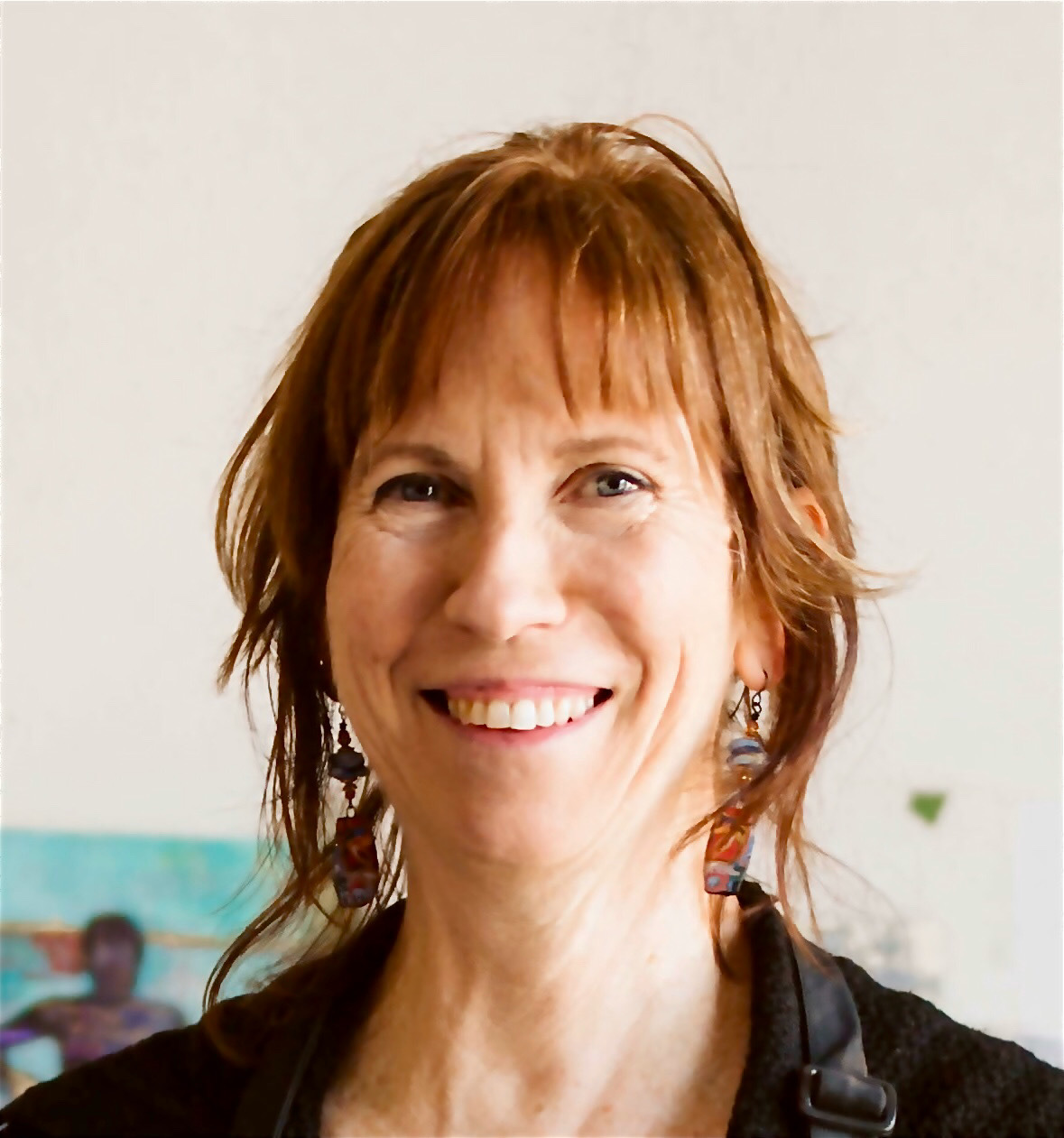
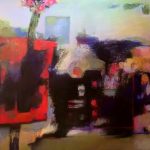




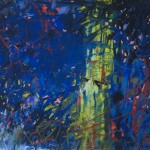


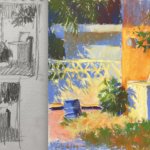
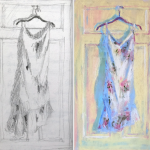



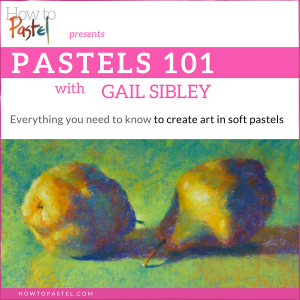

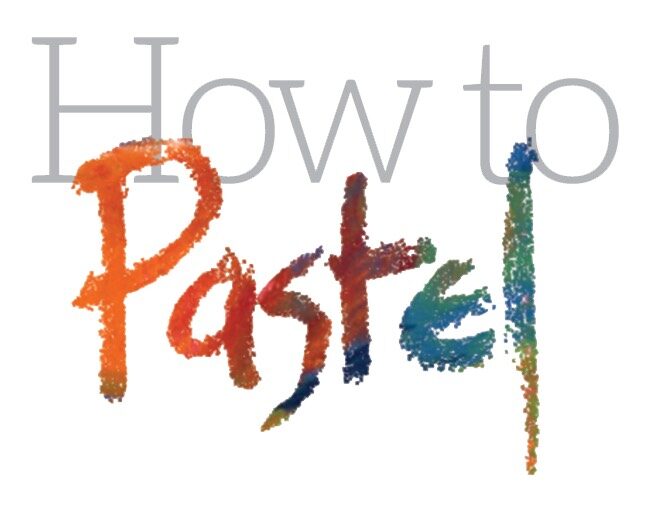

8 thoughts on “After the Bath – Edgar Degas’ Pastels of Women Drying Themselves”
Hi Gail,
Thank you for a wonderful presentation of my favorite pastellist Edward Degas.
You are right, he has an incredible way of describing the skin with pastel!
But have you noticed the back grounds? I find especially picture 2 and 9 wonderful, and the open door you mention is just there to give a dark color to the part of the body.
I have a book about his landscapes by Richard Kendall, where he is talking about these monotypes, but I still don’t get it. What is is that he does, make a print and paints on top of it, but how does he make a print, on the basis of an etching??
Looking at your Degas examples made me think of a website I saw recently: http://www.lamaisondupastel.com (the house of pastel) owned by Isabelle Roché, who inherited the old pastel business from her aunts.
Please take a good look around this website, especially the videos. These pastels have been produced in Paris since 1700 and Degas used them!!…and Isabelle uses the old recipes today to make them by hand.
Susana
Thanks Susana for you quick response to my blog going out!
Yes, the backgrounds are amazing. And yes, the doorway creates a dark foil for the light figure in #2 but also adds a sense of mystery don’t you think?
As to the monotypes, Degas would have put ink on a plate then wiped away areas and then made a print. Without doing anything, he would have made another print which would create a ghost of an image over which he worked. For more info, check this website: http://www.britishmuseum.org/explore/highlights/highlight_objects/pd/e/edgar_degas,_le_sommeil_sleep.aspx
I LOVE Henri Roche pastels and delight in talking with Isabelle at the IAPS Bi-Annual convention. These are pastels to save up for! Thank you for the link and for making the connection between Degas and Roche pastels. Degas also used Sennelier pastels. Many of the darks were especially crafted for him: http://www.sennelier.fr/Pastels-tendres-a-l-ecu_3.html
Thanks again for commenting. Which is your favourite??
Gail
Hi Gail,
I love your art history blogs ! I have always been a huge fan of Degas……!! I really like quite a few of them but if I have to pick…I like the second one. I enjoy the repetition of the circle motif in this one…even the bun in her hair mimics the end of the chair arm…
Thanks for your hard work sourcing the examples …
Wendy
Thanks so much Wendy! Yes, the second pastel is particularly lovely. Nice spotting of the circle motif 🙂
Oh Gail,
I find them all beautiful. I’m sitting in bed in hospital after hip surgery, and so I actually have time to sit and devour them!
I love number 9. His use of hatching intrigues me. As a relative beginner, I just can’t comprehend how that technique works so wonderfully, combined with the other techniques he uses to produce such a beautiful piece. I’m fascinated by it in all his pieces.
I love the colours in 3 and 7. I love up the sense of youth and energy in number 12.
Thank you so much for these posts, Gail. They bring what would be an otherwise unknown world of pastels to me, and I learn so much from your commentaries.
Thank you,
Jacquie
Jacquie I am so glad that my blog has given you something to take your mind off your surgery. And thanks for your input on favourites.
Degas’s hatching is unsurpassed – I am not really sure how he did it either!
I was going to mention the warm colours of #7 but forgot so I’m glad you did 🙂
Thank you for these, Gail. I got into Degas a couple of years ago, and particularly love his pastel paintings. I’m amazed, when I look at them, that he hatched the entire body in the same direction: for instance, a diagonal arm would still be hatched in vertically. And yet we still get the impression (excuse the pun) of contour through the colours he used, and the brevity and relative intensities of the hatching. Of course, In my clumsiness as a new pastellist, I would just use the side of the pastel and paint in the arm in a few strokes and then attempt to fix it.
There is much to be learnt from studying (and copying) the old masters.
Thanks for your observant comment Stephen. You are so right about Degas’ ability to hatch in one only direction yet be able to convey the feeling of a rounded form. Truly a master! And yes, lats to be learnt from the masters.
By the way, nothing wrong with using the side of the pastel to achieve form 🙂 It’s just another way of using the pastel. You could always try combining both methods.